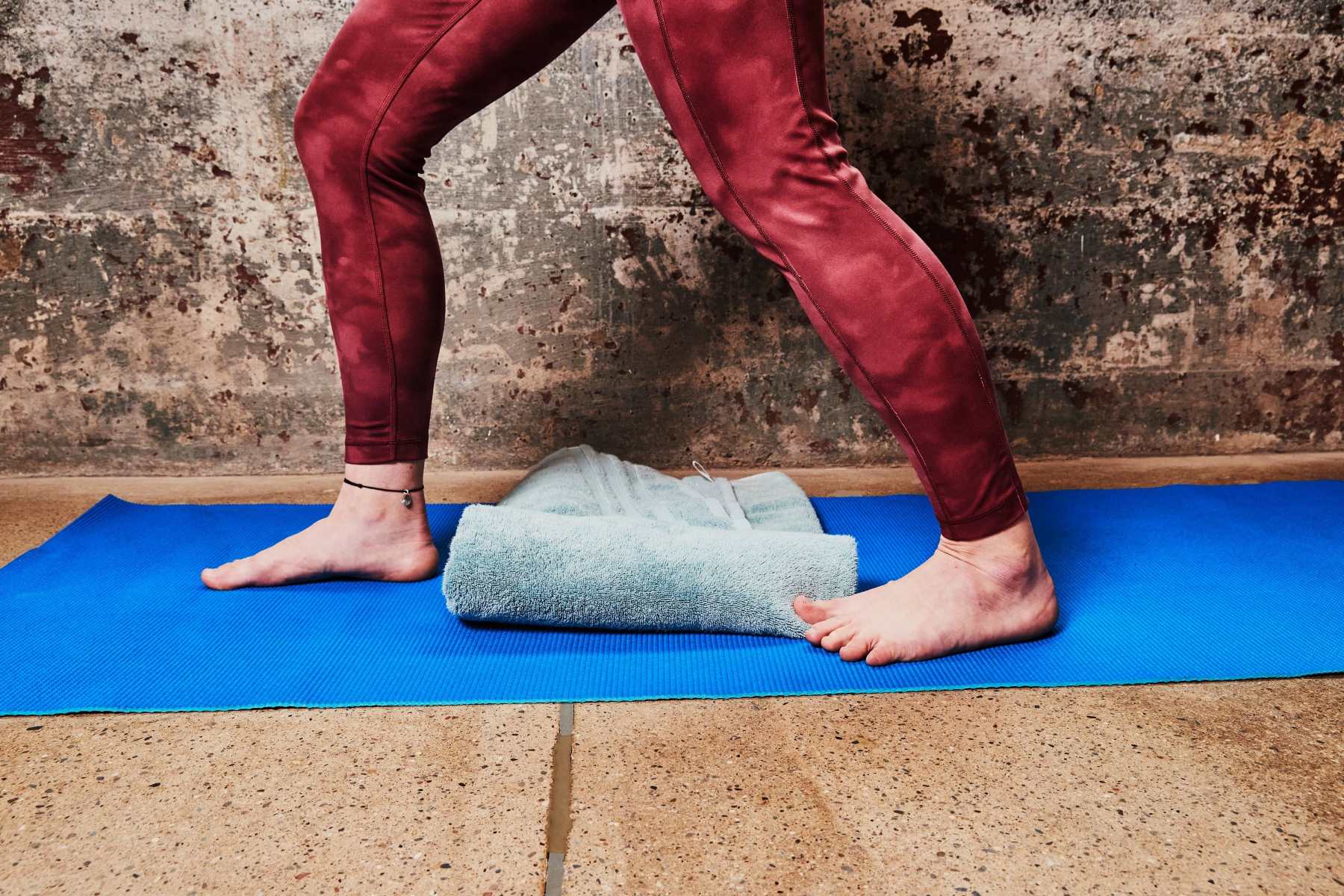Home>Training & Techniques>Running: The Bird Dog Exercise – A Guide On How To Perform And Its Benefits


Training & Techniques
Running: The Bird Dog Exercise – A Guide On How To Perform And Its Benefits
Published: March 1, 2024
Learn the proper technique and benefits of the Bird Dog exercise with our comprehensive guide. Improve your training and techniques for better results.
(Many of the links in this article redirect to a specific reviewed product. Your purchase of these products through affiliate links helps to generate commission for Therunningadvisor.com, at no extra cost. Learn more)
Table of Contents
Introduction
The Bird Dog exercise is a dynamic movement that has gained popularity for its effectiveness in improving core strength, stability, and overall body coordination. This exercise, often recommended by fitness experts and physical therapists, offers a myriad of benefits for runners looking to enhance their performance and reduce the risk of injury. Whether you're a seasoned runner or just starting out, incorporating the Bird Dog exercise into your training regimen can significantly contribute to your overall fitness and running prowess.
The Bird Dog exercise is a simple yet powerful movement that involves extending one arm and the opposite leg while maintaining a neutral spine position. This action engages the core muscles, including the abdominals, lower back, and glutes, to stabilize the body and promote balance. As a result, runners can experience improved posture, enhanced stability, and a stronger core, all of which are essential for maintaining proper form and preventing injuries during running.
In this comprehensive guide, we will delve into the intricacies of the Bird Dog exercise, including its proper form and technique, the specific muscles it targets, and the numerous benefits it offers to runners. Additionally, we will explore how to seamlessly integrate the Bird Dog exercise into your running routine, along with essential precautions and tips for beginners to ensure safe and effective execution. Whether you're aiming to boost your running performance, alleviate back pain, or simply enhance your overall fitness, mastering the Bird Dog exercise can be a game-changer in your fitness journey. So, let's embark on this enlightening exploration of the Bird Dog exercise and discover how it can elevate your running experience.
Understanding the Bird Dog Exercise
The Bird Dog exercise, also known as the Quadruped, is a fundamental movement that forms the cornerstone of many fitness routines, including those tailored for runners. This exercise is named after the way dogs stretch and extend their limbs, mimicking the motion of a bird dog pointing at its prey. The Bird Dog exercise primarily targets the core muscles, including the abdominals, lower back, and glutes, while also engaging the shoulders and upper back for stability.
To perform the Bird Dog exercise, start in a tabletop position on the floor, with your hands directly beneath your shoulders and your knees positioned below your hips. Maintain a neutral spine and engage your core muscles to stabilize your torso. From this position, simultaneously extend one arm straight out in front of you while extending the opposite leg straight back behind you. It's crucial to keep your hips level and avoid arching your back or rotating your torso. Hold this extended position for a few seconds before returning to the starting position and repeating the movement on the opposite side.
This exercise is deceptively simple yet incredibly effective in targeting multiple muscle groups and promoting overall body stability. The controlled, deliberate movements involved in the Bird Dog exercise help improve coordination, balance, and proprioception, which are essential for runners to maintain proper form and prevent injuries. Additionally, the Bird Dog exercise enhances core strength and endurance, which are vital for powering through long runs and maintaining optimal posture.
Understanding the mechanics and benefits of the Bird Dog exercise is crucial for runners looking to optimize their training regimen. By incorporating this exercise into your routine, you can build a solid foundation of core strength, improve body awareness, and enhance overall stability, ultimately contributing to improved running performance and reduced risk of injury. As we delve deeper into the proper form, targeted muscles, and benefits of the Bird Dog exercise, you'll gain valuable insights into how this simple yet impactful movement can elevate your running experience.
Proper Form and Technique
The proper form and technique are pivotal in maximizing the effectiveness of the Bird Dog exercise and minimizing the risk of injury. To execute this exercise with precision, it's essential to adhere to the following steps:
-
Starting Position: Begin in a tabletop position on the floor, with your hands directly beneath your shoulders and your knees positioned below your hips. Ensure that your wrists are aligned with your shoulders and your knees are aligned with your hips, forming a stable base for the exercise.
-
Neutral Spine Alignment: Maintain a neutral spine throughout the exercise to prevent excessive arching or rounding of the back. Engage your core muscles to stabilize your torso and avoid overarching, which can lead to strain on the lower back.
-
Engage Core Muscles: Prioritize engaging your core muscles, including the abdominals and lower back, to provide stability and support during the movement. This engagement is crucial for promoting proper form and maximizing the effectiveness of the exercise.
-
Extending Limbs: Simultaneously extend one arm straight out in front of you while extending the opposite leg straight back behind you. Focus on reaching through the extended arm and leg to create a straight line from your fingertips to your heel.
-
Hip and Shoulder Alignment: Keep your hips level and avoid rotating your torso as you extend your limbs. This ensures that the exercise effectively targets the core muscles while promoting balance and stability.
-
Controlled Movements: Emphasize controlled, deliberate movements throughout the exercise. Avoid jerky or rapid motions, and focus on maintaining stability and balance as you extend and retract your limbs.
-
Breathing: Coordinate your breathing with the movement by inhaling as you extend your arm and leg, and exhaling as you return to the starting position. This rhythmic breathing pattern enhances focus and promotes relaxation during the exercise.
By adhering to these key principles of proper form and technique, you can perform the Bird Dog exercise with precision and maximize its benefits. Consistent practice with attention to form will not only strengthen your core and improve stability but also contribute to enhanced body awareness and coordination, essential elements for runners aiming to optimize their performance and minimize the risk of injury.
Muscles Targeted
The Bird Dog exercise is renowned for its exceptional ability to target and engage multiple muscle groups, making it a highly effective movement for strengthening the core, improving stability, and enhancing overall body coordination. By understanding the specific muscles targeted during the Bird Dog exercise, individuals can gain valuable insights into the comprehensive benefits it offers for runners and fitness enthusiasts alike.
Core Muscles
The primary focus of the Bird Dog exercise is on the core muscles, including the rectus abdominis, transverse abdominis, and obliques. As the exercise requires maintaining a stable tabletop position while extending the limbs, the core muscles are actively engaged to stabilize the torso and prevent excessive movement of the spine. This engagement not only strengthens the core but also enhances overall body stability, which is essential for maintaining proper running form and reducing the risk of injury.
Lower Back
In addition to targeting the abdominal muscles, the Bird Dog exercise effectively engages the erector spinae, which are the muscles that run along the spine and play a crucial role in spinal extension and stabilization. By extending one leg at a time while maintaining a neutral spine, the lower back muscles are activated to support the spine and promote proper alignment. This targeted engagement of the lower back muscles contributes to improved spinal health and resilience, which is particularly beneficial for runners seeking to alleviate back discomfort and enhance their overall running performance.
Glutes
The extension of the legs in the Bird Dog exercise activates the gluteal muscles, including the gluteus maximus, medius, and minimus. These powerful muscles play a pivotal role in hip extension, abduction, and external rotation, all of which are essential for running mechanics. By targeting the glutes, the Bird Dog exercise helps strengthen the hip muscles, improve hip stability, and enhance overall lower body strength, ultimately contributing to improved running efficiency and reduced risk of hip-related injuries.
Shoulders and Upper Back
While the primary emphasis of the Bird Dog exercise is on the core and lower body muscles, the engagement of the shoulders and upper back should not be overlooked. As individuals extend their arms forward, the muscles surrounding the shoulder blades and upper back are activated to stabilize the upper body and promote proper alignment. This engagement contributes to improved posture, shoulder stability, and overall upper body strength, all of which are beneficial for runners aiming to maintain optimal running form and prevent upper body fatigue during long runs.
By comprehensively targeting these key muscle groups, the Bird Dog exercise offers a holistic approach to strengthening the body, enhancing stability, and improving overall coordination. This targeted engagement of multiple muscle groups aligns with the specific demands of running, making the Bird Dog exercise a valuable addition to any runner's training regimen. Whether you're striving to fortify your core, alleviate back discomfort, or enhance your running performance, the Bird Dog exercise stands as a versatile and effective movement that addresses the diverse needs of runners and fitness enthusiasts.
Benefits of the Bird Dog Exercise
The Bird Dog exercise offers a multitude of benefits that extend beyond core strengthening, making it a valuable addition to any runner's training regimen. By incorporating this dynamic movement into your routine, you can experience a range of advantages that directly contribute to improved running performance, enhanced stability, and reduced risk of injury.
Core Strength and Stability
One of the primary benefits of the Bird Dog exercise is its profound impact on core strength and stability. By engaging the abdominal muscles, lower back, and glutes, this exercise effectively targets the core, promoting greater strength and endurance in these crucial muscle groups. A strong and stable core is essential for runners, as it forms the foundation for proper running form, reduces the risk of lower back discomfort, and enhances overall body stability during running.
Improved Posture and Body Alignment
Consistent practice of the Bird Dog exercise can lead to improved posture and body alignment, which are essential for runners seeking to maintain optimal form and prevent fatigue-related compensations during long runs. The engagement of the core and lower back muscles in this exercise contributes to better spinal alignment, reducing the likelihood of slouching or overarching while running. Enhanced posture not only supports efficient running mechanics but also minimizes the risk of overuse injuries associated with poor alignment.
Enhanced Balance and Coordination
The Bird Dog exercise promotes enhanced balance and coordination by requiring controlled limb movements while maintaining a stable tabletop position. This focus on coordination is particularly beneficial for runners, as it contributes to improved body awareness and proprioception, essential elements for navigating uneven terrain and adapting to varying running speeds. By honing balance and coordination through the Bird Dog exercise, runners can enhance their agility and responsiveness, ultimately improving their overall running performance.
Injury Prevention and Rehabilitation
Incorporating the Bird Dog exercise into a runner's training routine can significantly contribute to injury prevention and rehabilitation. The targeted engagement of the core, lower back, and gluteal muscles helps fortify the body's support system, reducing the risk of common running injuries such as lower back strain, IT band syndrome, and hip instability. Additionally, the controlled nature of the Bird Dog exercise makes it a valuable tool for rehabilitating and strengthening muscles following an injury, aiding in the restoration of optimal running function.
Overall Functional Fitness
Beyond its specific benefits for running, the Bird Dog exercise contributes to overall functional fitness by targeting multiple muscle groups and promoting full-body coordination. This comprehensive approach to fitness aligns with the diverse demands of running, as it enhances overall strength, stability, and mobility, all of which are essential for optimal running performance. By integrating the Bird Dog exercise into your training regimen, you can cultivate a well-rounded level of functional fitness that supports your running endeavors and overall well-being.
In summary, the Bird Dog exercise offers a myriad of benefits that directly cater to the needs of runners, from core strengthening and injury prevention to improved posture and overall functional fitness. By embracing the versatility and effectiveness of the Bird Dog exercise, runners can elevate their training experience, enhance their running performance, and cultivate a resilient and balanced body capable of conquering any running challenge.
Incorporating the Bird Dog Exercise into Your Running Routine
Integrating the Bird Dog exercise into your running routine can yield substantial benefits, enhancing your overall performance and reducing the risk of running-related injuries. By strategically incorporating this dynamic movement into your training regimen, you can fortify your core, improve stability, and optimize your body's readiness for the demands of running.
Pre-Run Activation
Prior to embarking on a run, consider incorporating the Bird Dog exercise as part of your pre-run activation routine. Performing a set of Bird Dog repetitions can effectively engage your core muscles, activate stabilizing muscle groups, and prepare your body for the upcoming physical exertion. This pre-run activation primes your core and lower body, promoting better posture and stability as you transition into your running stride.
Cross-Training Sessions
Incorporating the Bird Dog exercise into your cross-training sessions can diversify your workout routine and target essential muscle groups that may not receive adequate attention during running. By including Bird Dog sets in your cross-training regimen, you can address core strength, stability, and coordination, complementing the cardiovascular and endurance aspects of your running workouts. This holistic approach to training contributes to overall body resilience and performance enhancement.
Post-Run Recovery and Rehabilitation
Following a challenging run, the Bird Dog exercise can serve as a valuable component of your post-run recovery and rehabilitation routine. Engaging in controlled Bird Dog movements can aid in alleviating muscle tension, promoting proper alignment, and facilitating the recovery of fatigued muscles. By integrating the Bird Dog exercise into your post-run routine, you can support muscle recovery, reduce the likelihood of post-run stiffness, and lay the foundation for enhanced performance in subsequent training sessions.
Interval Training Enhancement
Incorporating the Bird Dog exercise into interval training sessions can offer a unique opportunity to enhance core stability and coordination under varying levels of exertion. By integrating Bird Dog sets into your interval training regimen, you can challenge your core and lower body muscles in dynamic ways, simulating the demands of running at different intensities. This targeted approach to interval training can contribute to improved overall body control and resilience during runs.
Long-Term Performance Benefits
Consistent integration of the Bird Dog exercise into your running routine can yield long-term performance benefits, including improved core strength, enhanced stability, and reduced risk of injury. By making the Bird Dog exercise a regular component of your training regimen, you can cultivate a strong and resilient core, essential for maintaining proper running form and mitigating the impact of repetitive motion on the body. This proactive approach to training can lead to sustained improvements in running performance and overall physical well-being.
Incorporating the Bird Dog exercise into your running routine offers a multifaceted approach to enhancing core strength, stability, and overall body coordination, ultimately contributing to improved running performance and reduced risk of injury. By strategically integrating this dynamic movement into various aspects of your training regimen, you can unlock the full potential of the Bird Dog exercise and elevate your running experience.
Precautions and Tips for Beginners
As with any new exercise, beginners embarking on the journey of incorporating the Bird Dog exercise into their fitness routine should approach it with mindfulness and attention to proper form. Here are essential precautions and tips to ensure a safe and effective experience:
Start Slow and Focus on Form
For beginners, it's crucial to start with a slow and controlled pace when performing the Bird Dog exercise. Prioritize mastering the proper form and technique before aiming for higher repetitions or intensity. Focusing on form ensures that the targeted muscle groups are effectively engaged while minimizing the risk of strain or injury.
Engage Core Muscles Mindfully
Maintaining mindful engagement of the core muscles throughout the exercise is paramount for beginners. By consciously activating the abdominal and lower back muscles, beginners can establish a strong foundation for stability and support, reducing the likelihood of overarching or compromising spinal alignment.
Gradually Increase Intensity
As beginners become more familiar with the Bird Dog exercise, they can gradually increase the intensity by extending the duration of each repetition or incorporating slight variations, such as holding the extended position for an extra second. Incremental progression allows the body to adapt to the demands of the exercise while minimizing the risk of overexertion.
Focus on Breathing and Relaxation
Incorporating rhythmic breathing and maintaining a sense of relaxation during the Bird Dog exercise is essential for beginners. Coordinating inhalation and exhalation with the movement promotes a sense of ease and focus, enhancing the overall experience while reducing tension in the body.
Listen to Your Body
Beginners should attentively listen to their bodies and be mindful of any discomfort or strain during the exercise. If any pain or excessive discomfort is experienced, it's important to pause and reassess form and technique before continuing. Paying attention to the body's signals is crucial for preventing potential injuries.
Seek Guidance from a Fitness Professional
For beginners unfamiliar with proper exercise techniques, seeking guidance from a certified fitness professional or personal trainer can provide valuable insights and personalized instruction. A professional can offer tailored guidance, corrections, and modifications to ensure that beginners perform the Bird Dog exercise safely and effectively.
By adhering to these precautions and tips, beginners can embark on their Bird Dog exercise journey with confidence, gradually building core strength, stability, and coordination while minimizing the risk of injury. With patience, mindfulness, and a focus on proper form, beginners can lay a solid foundation for integrating the Bird Dog exercise into their fitness routine, reaping its numerous benefits over time.
Conclusion
In conclusion, the Bird Dog exercise stands as a foundational and transformative movement that holds immense potential for runners and fitness enthusiasts alike. Its ability to target the core, improve stability, and enhance overall body coordination makes it a valuable addition to any training regimen. By mastering the proper form and technique of the Bird Dog exercise, individuals can fortify their core, improve posture, and reduce the risk of running-related injuries.
The comprehensive engagement of key muscle groups, including the core, lower back, glutes, and upper body, underscores the holistic benefits of the Bird Dog exercise. Its impact extends beyond core strengthening, offering advantages such as improved posture, enhanced balance and coordination, injury prevention, and overall functional fitness. These benefits align with the specific demands of running, making the Bird Dog exercise a versatile and effective tool for optimizing running performance and sustaining long-term physical well-being.
Integrating the Bird Dog exercise into various aspects of a running routine, from pre-run activation to post-run recovery and rehabilitation, presents a strategic approach to enhancing core strength, stability, and overall body resilience. By embracing the multifaceted benefits of the Bird Dog exercise and incorporating it into cross-training sessions, interval training, and long-term training plans, individuals can unlock its full potential and experience sustained improvements in running performance.
For beginners, approaching the Bird Dog exercise with mindfulness, gradual progression, and a focus on proper form is essential for establishing a strong foundation and minimizing the risk of strain or injury. Seeking guidance from fitness professionals can provide valuable support and personalized instruction, ensuring that beginners embark on their Bird Dog exercise journey safely and effectively.
In essence, the Bird Dog exercise transcends its simplicity, offering a gateway to enhanced core strength, improved stability, and optimized body coordination. Whether you're striving to fortify your core, alleviate back discomfort, or enhance your running performance, the Bird Dog exercise stands as a versatile and effective movement that addresses the diverse needs of runners and fitness enthusiasts. Embracing the transformative potential of the Bird Dog exercise can elevate your running experience, cultivate resilience, and empower you to conquer any running challenge with confidence and strength.










